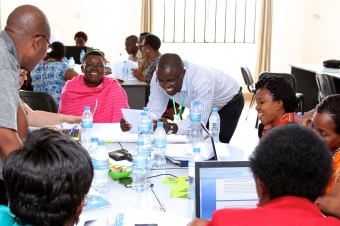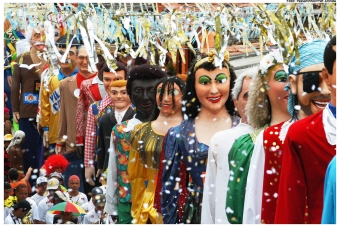Summary:
It is an activity that focuses on the verification of specific legal problems through field research. It is intended that students are able to identify and build socio-legal problems and can articulate them with constant theoretical tools in sociology texts, anthropology, among others. For that, they should elaborate a documentary based on a problem and articulated with one of these ideas in the theoretical texts worked out during the course.
Objective:
- GENERAL GOALS: the goal is to offer a space to develop (i) the ability to read and oral articulation on concrete problems and (ii) the use of techniques of observation and recording of the empirical world, especially of the audiovisual format. Additionally, to show high reflective potential of research in law based on observation of the institutions and authors that participate in them, and secondly, put the study of the evolution of ideas in the social sciences.
- SPECIFIC GOALS: The goal is to bring students to pursue concrete legal problems, identifying what the problem is, who is involved, when and where it occurs, stimulating that they seek these problems not only in the Judiciary but also in other institutions - legislative process, implementation of public policies, ONGs actuation, etc.
- It is intended that students develop:
1) the ability to identify different levels of observation on theoretical and empirical texts;
2) the ability to build and realize the construction of concrete socio-legal problems;
3) the ability to build analysis from the real problems observed.
Dynamics:
- TEACHING METHOD: documentary production, through which students look to portray a specific legal problem in audiovisual language, and in the light of a theoretical tool.
- REQUIREMENTS: The activity began in the first day of class and it was developed during the semester. There was an introductory class to the audiovisual language and documentary production technique for the guidance of students. The dynamic went parallel to the theoretical classes about the key concepts of interface field between law and social sciences.
For the debate about the ethical questions surrounding the audiovisual record, it was recommended the reading of João Moreira Salles, "A dificuldade do documentário", in Martins, Eckert e Novaes (org.), O imaginário e o poético em ciências sociais, Bauru: Edusc, 2005, pp. 57-71.
- INTRODUCTION TO THE DYNAMICS: the dynamics was developed in 4 different moments, 2 of them of dedicated to the preparation and 2 of them dedicated to the execution and evaluation:
1st MOMENT: on the first class of the dynamics, students gathered in the Computer Lab. The professor gave each student an exercise calling for the description of a specific legal problem, and the reasons why the student considered this a harmful, disturbing, destructive, unethical and harmful problem (Attachment 1). The students were able to consult the internet to build this problem. It was understood as a concrete legal problem a situation where it was possible to indicate "where", "how" and "who" was involved. The situation should also be current or have current implications. In the end of the class, the students gave the exercise to the professor.
2nd MOMENT: After a few theoretical classes to which the students read some epistemology, anthropology and sociology texts that developed conceptual tools for observing the legal problems. In the second class of the dynamics, the professor gave each of them a second exercise calling for a tool, a concept, a formula, or a theoretical distinction selected to observe, analyze or develop one or more aspects of the legal problem that were initially chosen. In the same exercise, they were asked to prepare a paragraph that articulated the specific legal problem with the chosen theoretical tool (Attachment 2).
- DEVELOPMENT OF THE DYNAMICS: It involved the creation of the documentary.
3rd MOMENT: After other lectures, in the third class of the dynamics, the professor showed to the class the problems of each and divided the classroom in groups. The groups were formed by the students themselves, according to the affinities of concrete legal problems that each of them had. They gathered according to their interests. Thus, for example, several students with gender problems got together and formed a group. There was no limit regarding the number of people, and there were students who preferred to be alone. Each group received an exercise in which they should formulate an argument to gather the selected legal problem, an approach from the theoretical tools discussed in class and, three, a development strategy of their audiovisual product, explaining which people they would interview, which they would shoot, etc. (attachment 3). This was a documentary script. It was stipulated that the videos should be up to 5 minutes. The students had 20 days to prepare documentaries, and they could talk to the professor to ask questions in the meantime.
- END OF THE DYNAMICS: It involved the presentation of the documentary and the professor's feedback time for students. 4th MOMENT: In a specific class, the documentaries of the groups were presented to the entire class. For each documentary, it was booked up to 20-30 minutes including presentation, group discussion and comments from the professor. It was questioned whether the content was consistent with the proposed approach, and what the documentary showed about the students themselves (allowing them to discuss questions related to the "point of view" of the documentary filmmaker and researcher), in addition to the narrated stories and articulation made with the data content in the classroom.
- ATTENTION IN THE CLASSROOM:
1) The students should know that images, soundtracks, sounds and noises are copyrighted. The professor showed them websites that offer free access to these materials. It also advised about the term of authorization of use of voice and image of the interviewed; 2) It is important to leave enough time for all documentaries to be watched and discussed, so that the students can have a feedback of their work. Depending on how many groups and produced documentaries, the 4th moment can take more than one class.
Evaluation:
- FEEDBACK: the written exercises were evaluated according to a grading of "excellent", "good", "regular" and "redo". The comments that were guided to work on the following criteria: full use of quotation rules by the academic community, clarity, accuracy of the theoretical tool used, the density and originality of the relationship between legal problem and theoretical tools. Exercises that repeated topics treated exhaustively in the classroom had a decrease in originality. The professor gave to the students the exercises with very abstract legal problems (example, "the problem of legal personality in Brazil"), so that they could be more elaborated.
- GRADE EVALUATION: the documentary composed 30% of the final grade of the semester. Half of this grade corresponded to written exercises meant to prepare the documentary. The other half matched the documentary itself. Using a language that was not dominated by students and involved a matter of esthetic criteria, it preferred to evaluate the commitment to this other language and not the end result. As a result, this second part of the grade was the highest for all those who produced the documentary.
Observation:
É possível criar um momento de pré-exibição no qual os alunos mostram os documentários e recebem sugestões sobre como aprimorá-los. Na atividade, o trabalho de acompanhamento foi feito fora da sala de aula;
Direitos autorais da imagem de capa:
Imagem: "8 mm Kodak film reel", 2008, disponibilizada pelo usuário do Wikimedia Commons "Coyau", foto de autoria do próprio usuário, sob a licença Creative Commons BY-SA-3.0
Time of application:
It is possible to create a moment of pre-view in which students show documentaries and receive suggestions on how to improve them. In the activity, the follow-up work was done outside the classroom;
Copyright from the cover page image:
Image: "8 mm Kodak film reel", of 2008, available by the Wikimedia Commons user "Coyau", picture from the own user, under the Creative Commons BY-SA-3.0 license.





